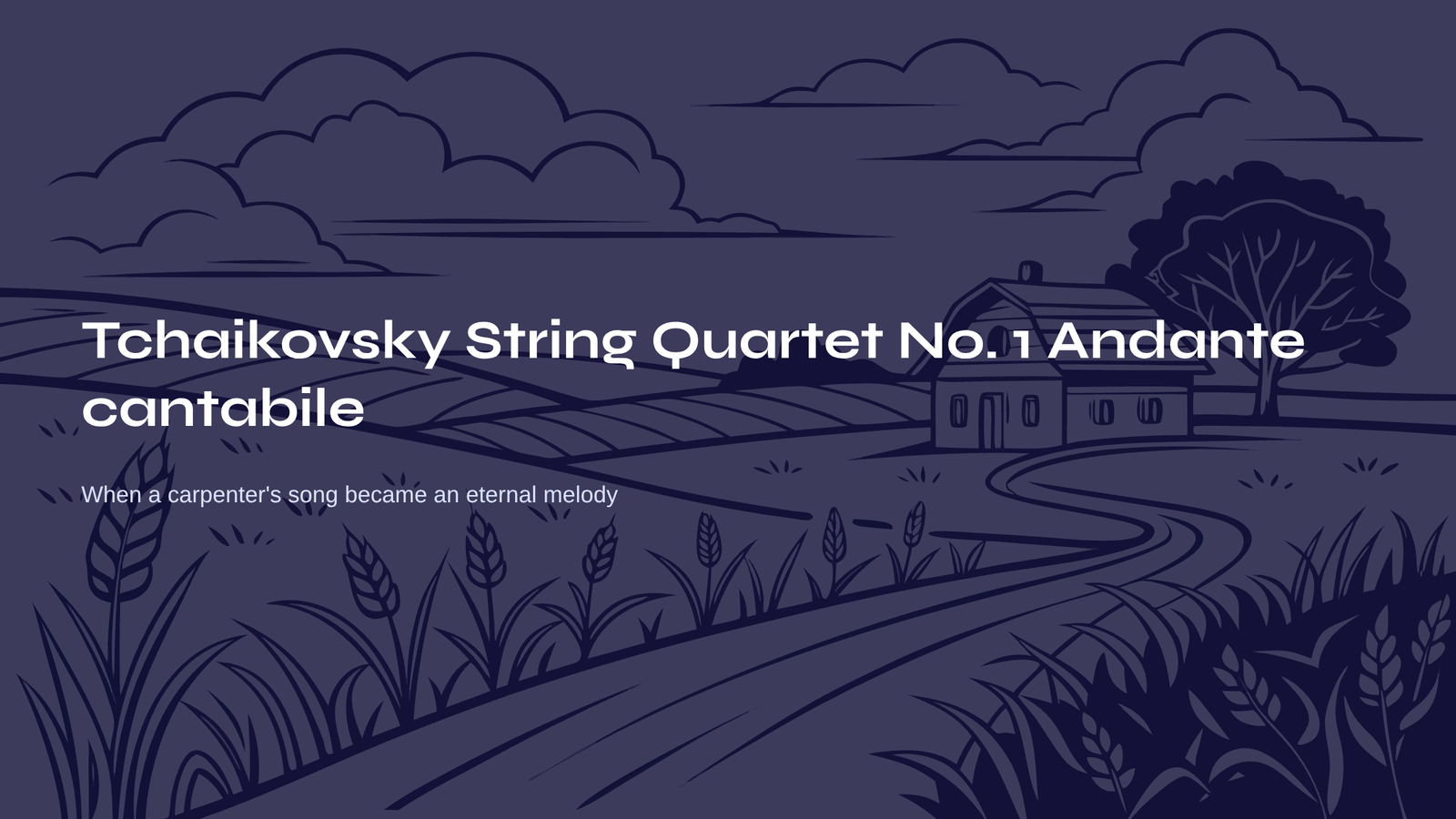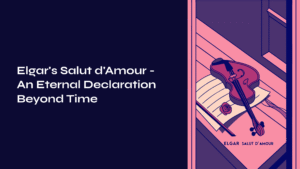Table of Contents

A Chance Encounter on a Summer Day
Summer 1869, the small Ukrainian village of Kamenka. Tchaikovsky was spending his vacation at his sister Alexandra’s estate. It was then that his ears caught a simple song hummed by a carpenter: “Vanya sat on the sofa drinking vodka.”
How ordinary those lyrics were! Yet within that melody flowed something indescribable—a stillness as if time had stopped, infused with deep nostalgia and sorrow. Tchaikovsky didn’t let that moment slip away.
Two years later, in 1871, he completed the second movement of his String Quartet No. 1 based on this folk song. This music would later move Tolstoy to tears, give Helen Keller a tactile experience of profound emotion, and continue to touch countless hearts to this day as an immortal melody.
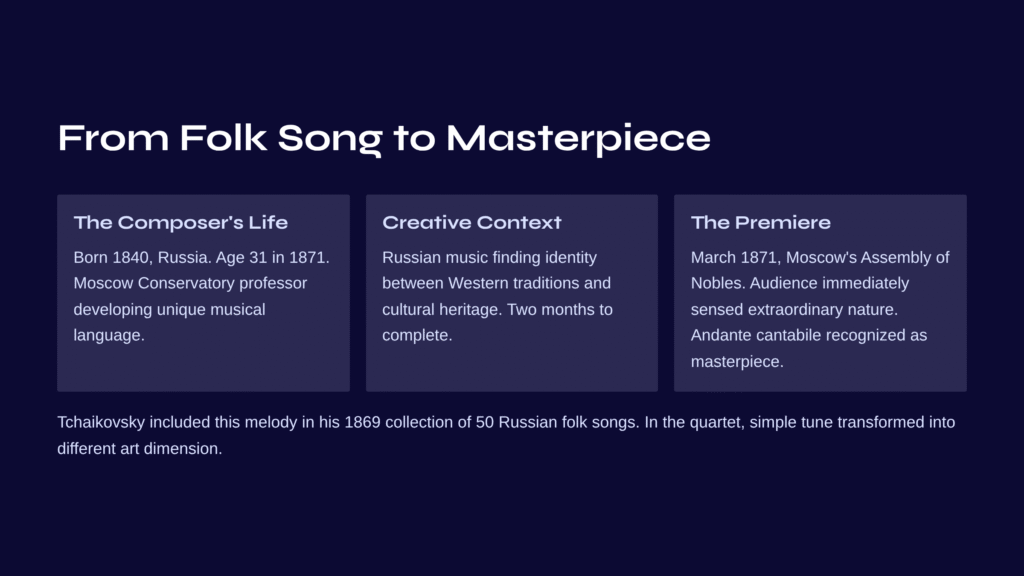
From Folk Song to Masterpiece
The Composer’s Life and Creative Context
Born in Russia in 1840, Pyotr Ilyich Tchaikovsky lived during an era when Russian music was finding its identity between Western European traditions and its own cultural heritage. In 1871, the 31-year-old Tchaikovsky was working as a professor at the Moscow Conservatory while developing his unique musical language.
String Quartet No. 1 in D major, Op. 11 was completed in just two months. When it premiered in March 1871 at Moscow’s Assembly of the Nobles, the audience immediately sensed the music’s extraordinary nature. The second movement, Andante cantabile, was quickly recognized as an independent masterpiece.
Tchaikovsky had already included this folk melody in his 1869 collection of 50 Russian folk songs for piano duet. However, in the string quartet, that simple tune was transformed into an entirely different dimension of art—not merely an arrangement, but a new creation based on the folk song’s emotional essence.
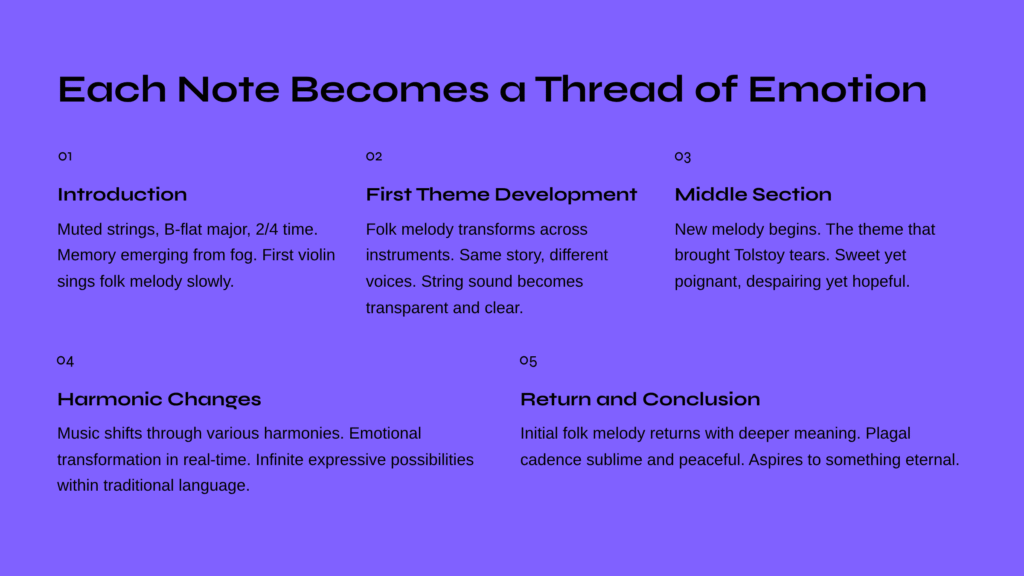
Each Note Becomes a Thread of Emotion
Introduction – A Melody Rising from Memory
The music begins with the mysterious sound of muted strings. B-flat major, 2/4 time. Like a memory dimly emerging from fog, the introduction is cautious and dreamlike.
When the first violin slowly begins to sing the folk melody’s opening phrase, we sense we’re entering something special. This melody is simple, yet the emotional density contained within is extraordinary. Nostalgia, sadness, and something like resignation blend together.
Development of the First Theme – The Story Unfolds
The folk melody undergoes various transformations across different instruments, yet the fundamental emotion remains unchanged. Like the same story told by different voices, each instrument sings that sorrow in its own way.
The string sound gradually becomes more transparent and clear. The ability to convey deep emotion through pure melody alone, without complex techniques or flashy ornamentation—this is the essence of Tchaikovsky’s music.
Middle Section – Tolstoy’s Tears
Then suddenly, the first violin begins singing an entirely new melody. This is that famous theme—the very melody that brought tears to Tolstoy’s eyes.
How can words capture the beauty of this melody? It’s simultaneously sweet and poignant, despairing yet hopeful. It’s as if all human emotions have been compressed into a single melodic line.
At the same time, the cello provides a regular accompaniment with pizzicato. When this simple “tap, tap, tap” rhythm meets the flowing melody above, the music transcends to an entirely different dimension. Structural stability and lyrical freedom achieve perfect balance.
Harmonic Changes – Subtle Colors of Emotion
In this section where the music delicately shifts through various harmonies, we witness the real-time process of emotional transformation. The sweetness of dissonance resolving, the shadows cast when moving from major to minor—all flow naturally.
Tchaikovsky doesn’t employ complex modern techniques here. Instead, he discovers infinite expressive possibilities within traditional harmonic language. This is why this music remains moving 150 years later.
Return and Conclusion – Quiet Transcendence
The music returns to the initial quiet folk melody. But now we know its depth. The same melody approaches us with completely different meaning.
The conclusion with its plagal cadence (IV-I) is as sublime and peaceful as church bells. It suggests this music aspires to something eternal, something sacred beyond mere earthly emotion.
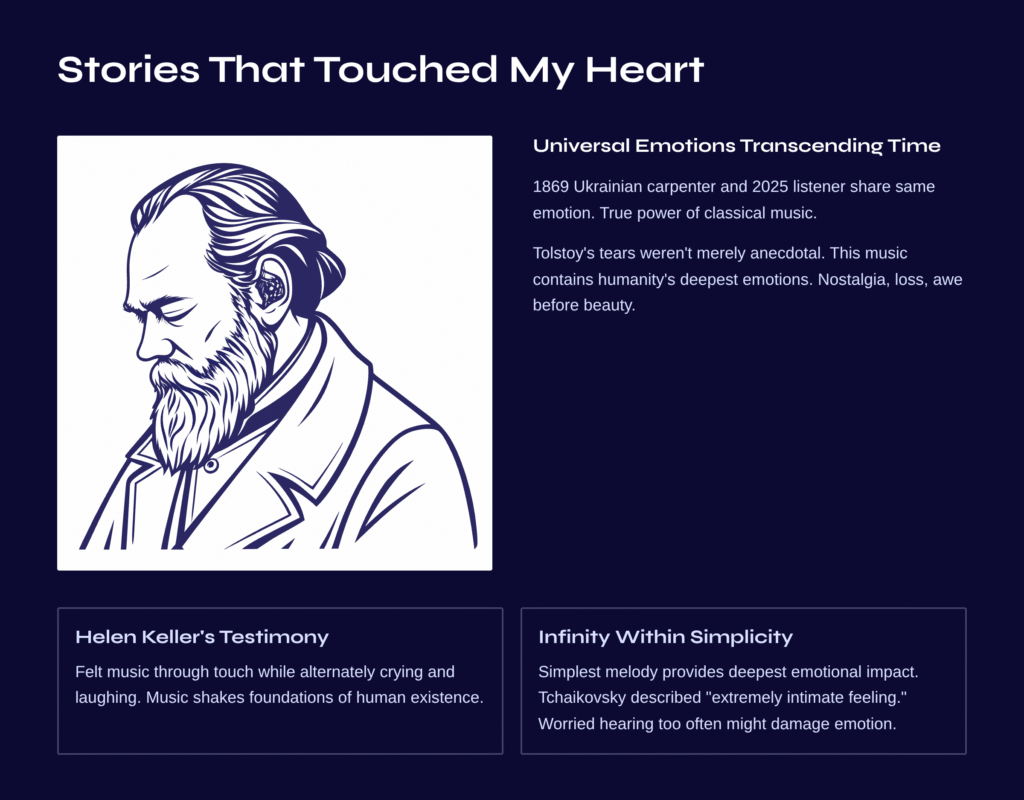
Stories That Touched My Heart
Universal Emotions Transcending Time
Every time I listen to this music, I experience something mysterious—the feeling that the 1869 Ukrainian carpenter and I in 2025 share the same emotion. Isn’t this universal feeling that transcends time and culture the true power of classical music?
The story of Tolstoy’s tears isn’t merely anecdotal. This music truly contains humanity’s deepest emotions. It might be nostalgia, or loss, or perhaps awe in the face of beauty.
Helen Keller’s testimony about feeling this music through touch while alternately crying and laughing is equally significant. It demonstrates music’s power to move beyond simple auditory experience and shake the very foundations of human existence.
Infinity Within Simplicity
We moderns often mistake complexity for depth. But this music demonstrates the opposite truth: the simplest melody can provide the deepest emotional impact.
Tchaikovsky himself described this piece as containing “extremely intimate feeling.” He worried that hearing it too often might damage that emotion. Such words from the composer reveal how deeply personal and precious the feelings behind this music were.
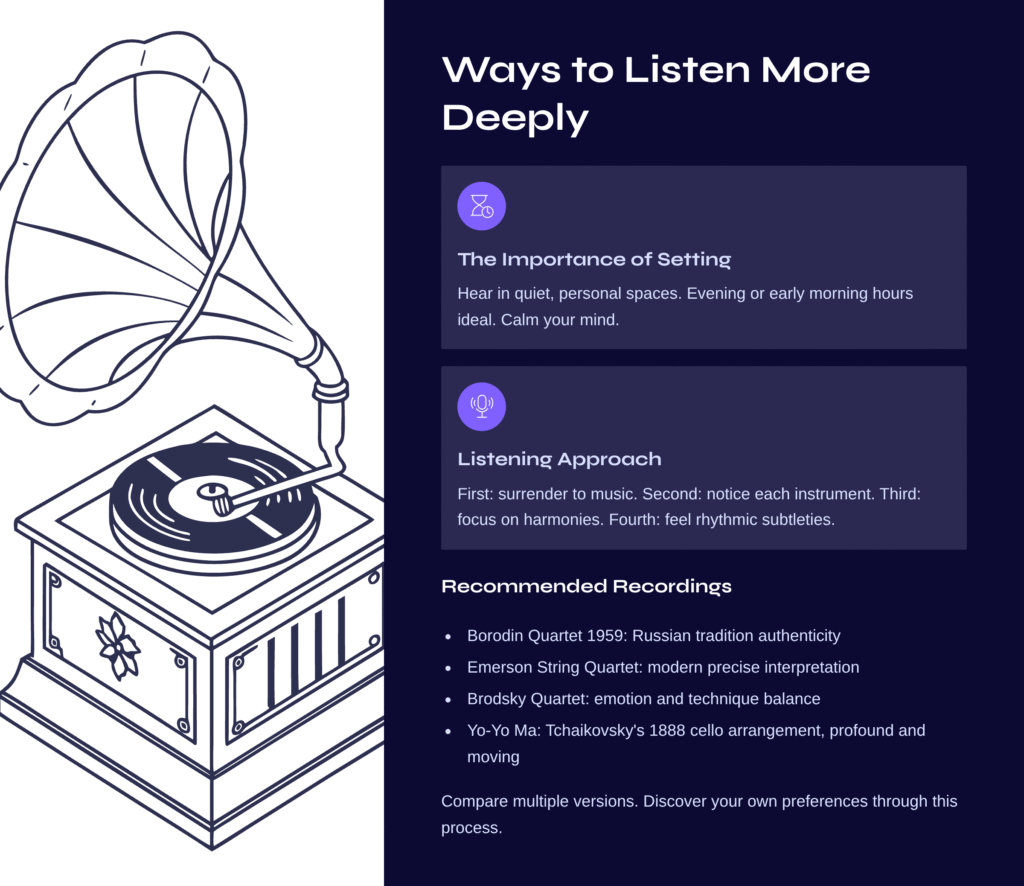
Ways to Listen More Deeply
The Importance of Setting
This music should be heard in quiet, personal spaces. Rather than concert hall grandeur, a small personal space where you can calm your mind is ideal—evening or early morning hours work particularly well.
On first listening, simply surrender to the music. Don’t try to analyze; just accept what you feel. On the second listening, notice each instrument’s role. The third time, focus on harmonic changes; the fourth, feel the rhythmic subtleties.
Recommended Recordings and Listening Points
The Borodin Quartet’s 1959 recording best demonstrates the authenticity of Russian tradition. The Emerson String Quartet offers modern yet precise interpretation, while the Brodsky Quartet shows excellent balance between emotion and technique.
I also recommend Tchaikovsky’s own 1888 arrangement for cello and string orchestra. Yo-Yo Ma’s performance is particularly profound and moving.
Since each performance offers slightly different interpretations, comparing multiple versions is valuable. Through this process, you’ll discover your own preferences.
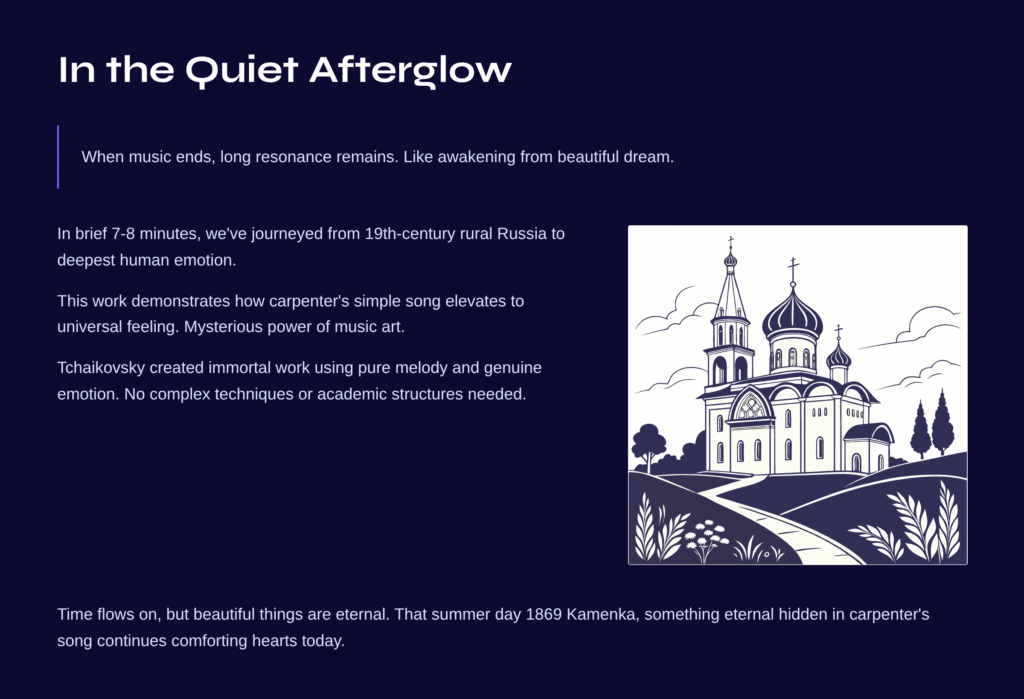
In the Quiet Afterglow
When the music ends, a long resonance remains. It feels like awakening from a beautiful dream. In these brief 7-8 minutes, we’ve journeyed from 19th-century rural Russia to the deepest reaches of human emotion.
This work perfectly demonstrates how a carpenter’s simple song can be elevated to universal human feeling, and what mysterious power the art of music possesses. Tchaikovsky created an immortal work using pure melody and genuine emotion instead of complex techniques or academic structures.
Time flows on, but beautiful things are eternal. That summer day in 1869 Kamenka, something eternal hidden in the carpenter’s song continues to comfort our hearts today.

The Next Musical Encounter
If you were moved by Tchaikovsky’s lyrical beauty, I recommend next exploring Grieg’s Norwegian Dance Op. 35 No. 2 (orchestral version).
This work harmonizes Nordic clarity with folk emotion, representing another masterful transformation of folk music beauty through a different approach than Tchaikovsky’s. Experience the fantastic sonic world created when Grieg’s characteristic lyrical melodies meet Norwegian traditional dance rhythms.
Orchestrated from the original piano version to become more brilliant and magnificent, this piece paints Scandinavian nature and culture in musical pearls. You’ll feel Grieg’s extroverted, vibrant energy contrasting with Tchaikovsky’s introspective lyricism.
